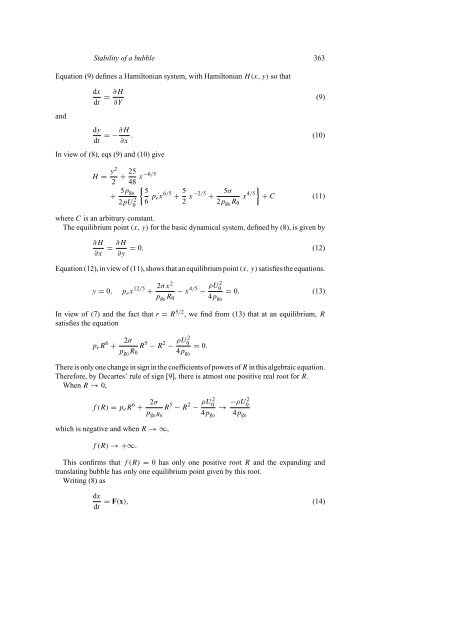Stability of a bubble expanding and translating through an inviscid ...
Stability of a bubble expanding and translating through an inviscid ...
Stability of a bubble expanding and translating through an inviscid ...
You also want an ePaper? Increase the reach of your titles
YUMPU automatically turns print PDFs into web optimized ePapers that Google loves.
<strong>Stability</strong> <strong>of</strong> a <strong>bubble</strong> 363<br />
Equation (9) defines a Hamiltoni<strong>an</strong> system, with Hamiltoni<strong>an</strong> H(x,y) so that<br />
<strong><strong>an</strong>d</strong><br />
dx<br />
dt<br />
dy<br />
dt<br />
= ∂H<br />
∂Y<br />
=− ∂H<br />
∂x . (10)<br />
In view <strong>of</strong> (8), eqs (9) <strong><strong>an</strong>d</strong> (10) give<br />
H = y2<br />
2 + 25<br />
+ 5p g 0<br />
2pU 2 0<br />
48 x−6/5<br />
{ 5<br />
6 p ex 6/5 + 5 2 x−2/5 + 5σ<br />
2p g0 R 0<br />
x 4/5 }<br />
+ C (11)<br />
where C is <strong>an</strong> arbitrary const<strong>an</strong>t.<br />
The equilibrium point (x, y) for the basic dynamical system, defined by (8), is given by<br />
∂H<br />
∂x = ∂H<br />
∂y<br />
= 0. (12)<br />
Equation (12), in view <strong>of</strong> (11), shows that <strong>an</strong> equilibrium point (x, y) satisfies the equations.<br />
(9)<br />
y = 0,<br />
p e x 12/5 + 2σx2<br />
p g0 R 0<br />
−x 4/5 − ρU2 0<br />
4p g0<br />
= 0. (13)<br />
In view <strong>of</strong> (7) <strong><strong>an</strong>d</strong> the fact that r = R 5/2 , we find from (13) that at <strong>an</strong> equilibrium, R<br />
satisfies the equation<br />
p e R 6 +<br />
2σ<br />
p g0 R 0<br />
R 5 − R 2 − ρU2 0<br />
4p g0<br />
= 0.<br />
There is only one ch<strong>an</strong>ge in sign in the coefficients <strong>of</strong> powers <strong>of</strong> R in this algebraic equation.<br />
Therefore, by Decartes’ rule <strong>of</strong> sign [9], there is atmost one positive real root for R.<br />
When R → 0,<br />
f(R)=p e R 6 +<br />
which is negative <strong><strong>an</strong>d</strong> when R →∞,<br />
f(R)→+∞.<br />
2σ<br />
p g0 R 0<br />
R 5 −R 2 − ρU2 0<br />
4p g0<br />
→ −ρU2 0<br />
4p g0<br />
This confirms that f(R) = 0 has only one positive root R <strong><strong>an</strong>d</strong> the <strong>exp<strong><strong>an</strong>d</strong>ing</strong> <strong><strong>an</strong>d</strong><br />
<strong>tr<strong>an</strong>slating</strong> <strong>bubble</strong> has only one equilibrium point given by this root.<br />
Writing (8) as<br />
dx<br />
dt<br />
= F(x), (14)
















